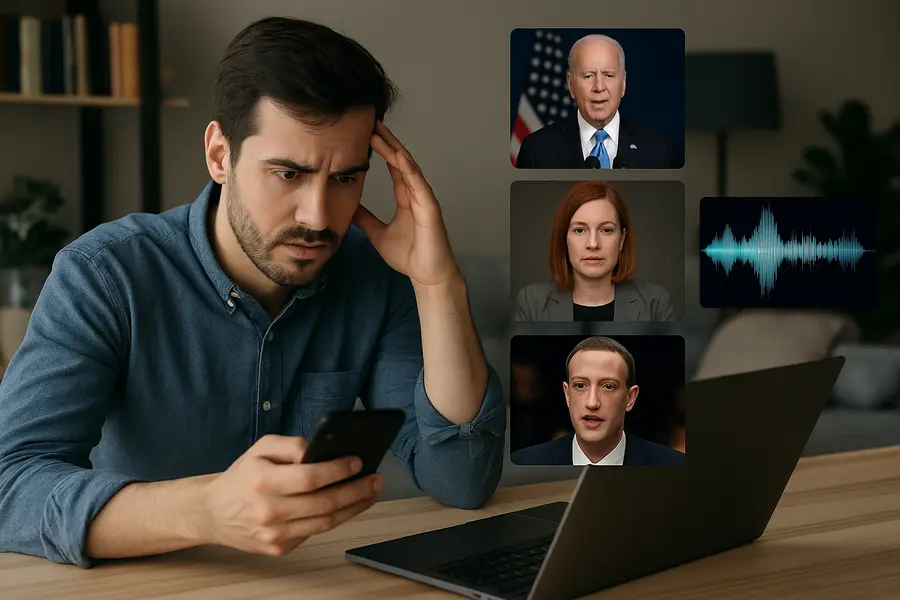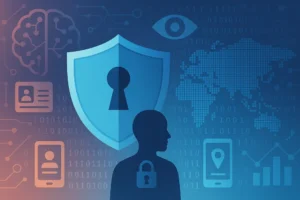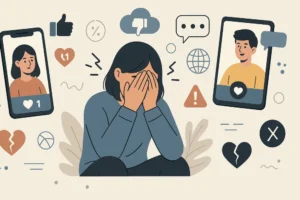Deepfake Technology Is Eroding Media Credibility and Public Trust in the Digital Age
Have you ever watched a video that looked completely real—only to find out later it was totally fake? That’s the world of deepfakes, where clever AI can swap faces, clone voices, and bend reality in ways that feel eerily authentic.
In today’s digital age, these convincing forgeries are popping up everywhere: social media feeds, news clips, even political speeches.
As we scroll, share, and comment, it’s getting harder to know what to trust. Suddenly, every video call or headline could be hiding a trick.
And when we can’t tell the truth from manipulation, our confidence in each other—and in the institutions we rely on—starts to crack.
Deepfake technology blurs truth and fiction, challenging digital ethics and demanding stronger safeguards to protect public trust.
In this article, we’ll dive into how deepfake technology is quietly chipping away at social trust, and why understanding this trend is more important than ever.

The sociology of Deepfake Technology and Social Trust
Deepfake technology—synthetic media in which a person in an existing image or video is replaced with someone else’s likeness—has rapidly evolved from a niche novelty to a powerful tool capable of eroding social trust at multiple levels.
While early deepfakes were limited in quality and scope, recent advancements in generative adversarial networks (GANs) have made them increasingly realistic and accessible, raising profound questions about what can be believed in the digital age.
Sociologists are particularly interested in how deepfakes influence the fabric of social trust—defined as the confidence individuals place in institutions, media, and each other.
Let’s explore the sociological dimensions of deepfake technology, examining its history, theoretical underpinnings, impacts on various forms of trust, and potential strategies for mitigation.
The Evolution of Deepfake Technology
The term “deepfake” emerged around 2017 when online forums began sharing AI-generated celebrity face swaps.
Early methods were rudimentary, producing glaring artifacts that made detection relatively straightforward.
However, within just a few years, the integration of more sophisticated neural network architectures—particularly GANs—enabled the generation of high-resolution, near-seamless videos and audio clips.
By 2024, researchers had demonstrated deepfakes indistinguishable from genuine footage in blind tests, highlighting the rapid pace of improvement.
Today, open-source deepfake tools are freely available on platforms like GitHub, lowering technical barriers and democratizing access for both benign uses (e.g., in film and education) and malicious ones (e.g., political manipulation).
Theoretical Frameworks on Social Trust
In sociology, trust is often conceptualized through the lenses of relational, institutional, and systemic trust.
Relational trust refers to confidence in personal relationships; institutional trust concerns faith in organizations such as the media, government, or corporations; and systemic trust pertains to belief in broader social systems and norms.
Niklas Luhmann argued that trust reduces social complexity by allowing individuals to act without exhaustive verification of every interaction. Anthony Giddens emphasized trust as a precondition for modern institutions to function smoothly.
Deepfakes challenge all three forms: they can distort personal interactions, delegitimize traditional media sources, and undermine confidence in societal norms around authenticity and evidence—even when those norms have yet to fully account for synthetic media.
Impact of Deepfake Technology on Interpersonal Trust
Deepfake technology can make anyone’s face or voice look and sound real. This causes people to doubt what they see and hear.
When a friend sends a video, you might wonder if it was altered. Non-consensual deepfake images and videos can harm personal reputations and feelings.
Voice cloning scams have tricked people into sending money to strangers. Such incidents make it hard to trust phone calls or video chats.
Couples may argue if one partner fears the other made a fake message. Families can become wary of sharing personal moments online.
For example, non-consensual deepfake pornography—where women’s faces are superimposed onto explicit videos—has had devastating effects in South Korea, with victims reporting severe trauma and a breakdown of trust in both friends and social networks that circulate such material.
To rebuild trust, people must learn to check sources carefully. Simple steps like verifying messages with a phone call help. Open conversations about deepfakes keep relationships strong.
As awareness grows, friends and loved ones will support each other in spotting fakes. In this way, we can protect our personal bonds despite new digital threats.
Impact of Deepfake Technology on Institutional Trust: Media and Politics
Deepfake technology lets anyone create videos that look real, even in news reports. Viewers may struggle to tell genuine footage from fake. This uncertainty can weaken trust in media outlets. When fake videos spread online, people start to doubt reporters.
Politicians also face deepfake attacks. A fabricated speech or interview can mislead voters about a candidate’s views. Such lies can influence election results.
People may stop believing any political message. This harms democratic discussions and civic engagement. Media companies invest in AI tools to detect deepfakes.
Governments create rules to punish malicious use. Fact-checkers label videos to warn audiences.
News outlets partner with tech firms to train staff in deepfake detection. Educational programs teach people how to spot signs of video tampering.
When institutions act quickly, they can limit the damage of fake content. With shared effort, society can rebuild faith in media and politics.
A scoping review published in May 2025 found that deepfake content significantly blurs the boundary between truth and fiction, eroding media credibility and fueling societal polarization.
Politically, synthetic media have already been deployed in attempts to suppress voter turnout—most notably a robocall mimicking President Joe Biden that targeted minority communities during the 2020 U.S. election. This demonstrates how deepfakes can manipulate democratic processes and shake public confidence in electoral integrity.
Social Polarization and Cultural Fragmentation
Beyond individual and institutional realms, deepfakes contribute to broader social fragmentation.
When people cannot agree on a shared reality—when any piece of evidence can be dismissed as “fake”—societies risk descending into epistemic anarchy, where debates settle not through evidence-based argumentation but via ideological echo chambers.
Vaccari et al. (2020) showed that exposure to deepfake misinformation on social media increases affective polarization, making individuals more distrustful of out-group perspectives and less willing to engage in collective problem-solving.
This dynamic exacerbates preexisting divisions—political, ethnic, or cultural—by weaponizing doubt itself as a tool of influence.
Economic and Corporate Implications of Deepfakes
Deepfake technology is reshaping the business world in several ways. Companies face new financial risks when scammers use cloned voices or faces to authorize fake transactions.
In one case, a CEO’s voice was mimicked in a phone call, and the firm lost millions of dollars in seconds.
Insurance companies are now creating policies to cover deepfake-related losses. This adds to costs for businesses across all industries.
Brands worry about their reputations when fake ads or endorsements appear online. Removing harmful content requires extra spending on legal fees and public relations.
At the same time, firms invest in AI tools to detect synthetic media. These tools bring ongoing subscription fees and staff training expenses.
North Korean hackers reportedly used stolen identities alongside deepfake techniques to infiltrate tech firms, causing data breaches and ransomware attacks that netted billions for Pyongyang’s regime.
Cybersecurity teams must learn about deepfake tactics and update their defenses.
Some companies explore deepfake uses for positive purposes, like personalized marketing or virtual training. However, they must balance creativity with ethics to avoid public backlash.
Overall, deepfake technology forces businesses to rethink security, trust, and investment strategies in a rapidly changing digital age.
The Role of Detection Technologies
In response to these threats, researchers and tech companies have developed countermeasures that leverage AI to detect synthetic media.
For instance, models trained to identify subtle inconsistencies in facial muscle movement or voice timbre can flag potential deepfakes with growing accuracy—some reporting detection rates above 95% in controlled environments.
However, it remains an arms race: as detection methods improve, so do generation techniques, incorporating adversarial training to bypass forensic analyses.
Moreover, overreliance on automated detection can create a false sense of security, underscoring the need for complementary social strategies.
Empowering Minds: Media Literacy and Public Education
Teaching people how to understand and check digital content is key to fighting deepfake threats.
Schools and community centers can offer simple lessons on spotting edited videos and fake audio.
For example, learners can practice looking for mismatched lip movements or odd lighting in videos.
Public workshops and online tutorials help adults and seniors learn these skills too.
News organizations can partner with educators to share tips on social media. Clear, step-by-step guides make it easy for everyone to follow.
Governments and libraries can distribute free checklists and posters that show red flags of deepfakes.
Local TV and radio stations might run short segments on how to verify sources. In workplaces, companies can hold quick training sessions on safe sharing and fact-checking.
Parents can reinforce these lessons at home by watching news together and asking questions.
Over time, these efforts build a culture of healthy skepticism and critical thinking. When people learn to pause, verify, and question, they become active defenders of truth.
Media literacy turns every citizen into a watchdog, helping society stay strong and united in the face of rapidly changing technology.
Legal and Regulatory Frameworks
Governments around the world are scrambling to develop legal frameworks that deter malicious use of deepfakes.
South Korea recently amended its criminal code to penalize the creation and distribution of non-consensual deepfake pornography, marking a significant step toward protecting individual rights and trust in digital spaces.
In the United States, bipartisan bills have been proposed to label political deepfake content and impose penalties for misrepresentation during elections.
The European Union is advancing its Digital Services Act to require platforms to implement robust content verification measures.
While regulation must balance innovation with protection, these efforts reflect a growing recognition that legal deterrence is essential for preserving social trust.
The Future of Social Trust in an Age of Synthetic Media
In an era where synthetic media—from hyperrealistic deepfaked videos to AI-generated voices—becomes increasingly woven into daily life, social trust will evolve into an active, collective achievement rather than a passive expectation.
Rather than assuming any image or clip is genuine, individuals and institutions will rely on layered verification. Machine-driven authenticity checks (for example, blockchain-anchored “proof of origin” metadata), human-centered media literacy programs, and transparent reporting standards that clearly label synthetic content.
The ethical landscape of deepfakes is complex. Not all synthetic media is malicious—artists and educators have harnessed deepfakes to create immersive historical reenactments, revive endangered languages, and develop therapy tools for neurological disorders.
Yet, the very same technology that can bring benefits also wields the power to deceive on a massive scale.
Sociologists argue for an ethical framework grounded in “responsibility by design,” where developers incorporate safety features and transparency mechanisms—such as embedded metadata indicating synthetic origin—into generative platforms from the outset.
Platforms and regulators will collaborate to embed these safeguards, while educational systems will teach critical evaluation skills from an early age.
At the same time, new civic norms around information sharing will emerge, valuing open source tools and community-driven fact-checking over closed, opaque algorithms.
As a result, trust will hinge less on accepting content at face value and more on participating in a shared ecosystem of verification and accountability—transforming trust into a dynamic social practice that balances technological innovation with collective responsibility.
Read Here: The Impact of Social Media Algorithms on Polarization
Conclusion: Deepfake Technology and Social Trust
Deepfake technology can both entertain and deceive. It has changed how we see videos and hear voices.
At the same time, it can harm relationships and trust. When people worry about fakes, they might doubt real news. This can weaken trust in friends, media, and institutions.
To protect trust, we need tools, rules, and education. Developers should build detection features into their software.
Governments and platforms must set clear rules against harmful content. Schools and communities can teach people to spot deepfakes. This combined effort makes it harder for fakes to spread. In the end, society must work together.
We must encourage ethical deepfake creation and clear labeling so viewers know what is real.
Fact-checkers and community groups help verify materials. Simple habits like checking sources make a big difference. Together, we can enjoy deepfake creativity and keep social bonds intact.
Read Here: Digital Privacy Concerns in the Age of Big Data





